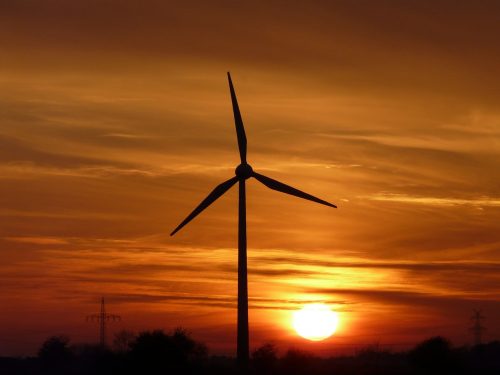Google have announced they are set to reach their goal of 100 percent renewable energy in 2017.
In a recent blog post, Urs Hölzle, Google’s Senior Vice President for Technical Infrastructure, explains what they mean by 100 percent renewable energy:
“To reach this goal we’ll be directly buying enough wind and solar electricity annually to account for every unit of electricity our operations consume, globally.”
 Google purchases clean electricity directly from wind and solar farms near the company’s data centers around the world. Image: pixabay-1004364
Google purchases clean electricity directly from wind and solar farms near the company’s data centers around the world. Image: pixabay-1004364
The internet giant first made the commitment to buy enough renewable energy to match 100 percent of its global operations – both data centers and offices – in 2012.
Google is now the largest corporate buyer of renewable energy in the world. The firm’s commitments total 2.6 gigawatts of wind and solar energy – the equivalent of taking 1 million cars off the road.
In addition, the company has committed to $3.5 billion infrastructure investments in renewable energy projects from which they already purchase electricity. About two-thirds of the investments are in the United States.
“The projects will provide tens of millions of dollars in local taxes for communities and lease revenues for landowners,” note Google in a white paper that outlines the company’s next steps.
What it means to reach 100 percent renewable energy
Google’s 100 percent renewable energy goal means that on an annual basis, the company will buy the same amount of renewable energy (measured in megawatt hours – MWh) as it consumes in its data centers and offices worldwide.
To understand what this means, we have to understand how the electricity grid works.
We know that electricity generated in a power plant cannot be directed to a specific user over the electricity grid any more than a cup of water poured into a reservoir can be directed to a particular household.
Given that all sorts of energy types make electricity for the grid, how do you commit to being a 100 percent renewable energy user?
One option is not to use the grid at all – you could build your own plant next to your data center. But this is not sensible for large data centers in cities. Renewable energy plants need to be situated in spots that make best use of wind and solar energy.
Also, because of the intermittent nature of wind and solar energy, and the fact we have not yet solved the problem of mass energy storage, it is not possible to rely on these sources to provide the continuous, smooth 24/7 supply needed by large data centers.
So an alternative approach is to buy renewable energy in competitive wholesale markets – and invest in renewable energy plants that contribute to those markets.
For example (see diagram), on grids on which Google has a data center, the company buys fixed-price bundles of physical renewable energy and renewable energy credits (RECs) directly from a wind or solar farm under long-term contracts.
 Image adapted from Google blog
Image adapted from Google blog
They then resell the physical renewable energy into the wholesale market at a floating (variable) market rate.
The data center then buys smooth, 24/7 energy from their regulated utility, and applies the RECs to their bills.
The 100 percent renewable energy goal is reached when, over a year, the total number of RECs applied equals the total consumption.
Green energy purchasing
Google purchases clean electricity directly from wind and solar farms near the company’s data centers around the world. The company is also working with utility partners to make more renewable energy available for the company’s expanding need and for others.
The following is a list of the projects purchased to date in U.S. states and other countries:
– California: Golden Hills (43 MW of wind)
– Iowa: Story County II (114 MW of wind); Wind VIII (up to 407 MW of wind)
– Kansas: Cimarron Bend (200 MW of wind)
– North Carolina: Duke Solar (61 MW of solar)
– Oklahoma: Canadian Hills (48 MW of wind); Minco II (101 MW of wind); Bluestem (198 MW of wind); Great Western (225 MW of wind)
– Texas: Bethel (225 MW of wind); Happy Hereford (239 MW of wind)
– Chile: El Romero (80 MW of solar)
– Sweden: Ramsnäs, Skalleberg, Mungseröd, Alered (60 MW of wind); Jenasen (76 MW of wind); Beaufort (76 MW of wind); Maevaara (105 MW of wind)
– Netherlands: Delfzijl (63 MW of wind)
– Norway: Tellenes (160 MW of wind)

